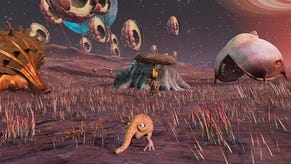The Eternal Cylinder review: an outlandish, delightful, and surprisingly approachable survival adventure
Entirely platonic Darwinism
Deep in the endless sediment of the ancient, fossilised internet, it is possible to find signs of an interview in which I spoke to ACE Team about their weird beat ‘em up sequel, Zeno Clash 2. Company founder Carlos Bordeu finished up that interview by saying: “aesthetic choices have been intentionally made to make our game stand out from the mass of traditional fantasy games that continue to mimic each other”. I feel that it’s probably fair to say that these choices have continued to be made almost a decade later, with Bordeu now the game director of The Eternal Cylinder, a game about a giant cylinder.
But is it really about a giant cylinder? And what do such esoteric choices add up to in this latest Ace Team venture into the unfamiliar? Let’s find out.
The truth is that The Eternal Cylinder is less about its primary and titular antagonist, the giant cylinder which is crushing a colourful alien world beneath its red hot immensity, than it is about its protagonists, the trunk-snouted trebhum: a bipedal not-people who are the emotional and gameplay heart of this lovely, remarkably approachable game.
In some ways The Eternal Cylinder is less weird than its premise suggests. At a purely tactile, moment-to-moment game level it does feel less immediately unusual to play than the Zeno Clashes, or even Abyss Odyssey. The controls are instantly comprehensible to anyone who has done a bit of running and jumping in a third-person game, and the loop of hoovering up resources to continue playing has become a familiar default.
As a trebhum, your role is to stay alive and to hatch, resuscitate, or free other trebhum to join your family. Once joined, they scamper around after you, and can be switched to at will, allowing you some options to deal with the challenges you face, and some get-out-of-game-over options for when your primary lad gets eaten or flattened. Yes, sometimes the little snoutbeasts die, but if one survives then others can be rescued from death via some weird altar thing and a bellyful of crystal dust. More broadly, you must avoid starving to death, being eaten or squashed by any of the ecosystem of weird creatures which chomp and wallop their way across the world’s alien landscapes, and, ultimately, you must evolve.
"You must avoid starving to death, being eaten or squashed by any of the ecosystem of weird creatures which wallop their way across the alien landscapes, and, ultimately, you must evolve."
The Eternal Cylinder has snorted up various aspects of the survival genre to make this conceit work. Unlike most survival games, however, the experience is a more linear one, because to survive you must continue to move forward to avoid being crushed, and so that linearity is a sort wide and packaged corridor: the cylinder is halted at various junctures, and you get to explore a strip of land in front of it, filling your stomachs and doing what you can to make the most of the resources at your disposal.
Stomachs, yes. Eating, or at least hoovering stuff up to store it and then pumping directly into… another hole, is the background loop which powers the game along. Some of the things you eat have an even more immediate effect on your trebhum than restoring energy levels because they cause changes. Yes, this is not evolution in the breeding sense (thank goodness) but one in which you transform your creatures depending on your deepening needs via eating cubes, crystals, seeds, and weird fungus. Some of these mutations are passive effects, which allow you to traverse further, faster, boosting your stamina, or covering you in fur to survive low temperatures, and things like that. More dramatically though, there are also numerous set pieces throughout the game which demand that you evolve to defeat them: things such as a switch that requires you to turn into a cube to activate it, or a puzzle which requires you to have sucker feet to reach the goal, or an obstacle which you must inflate like a balloon to float over the vast dead body of some sort of infinite space eel which lies decomposing in the sea ahead of you. Some of these set pieces are clever and fun, others are frustrating.

There’s quite a lot here, with a broad range of mutations for different purposes. There was a degree to which I felt in danger of confusion, but the system unfolded carefully over a long time and I was surprised at how rarely I stumbled into situations where I died unfairly because I didn’t have the right mutations selected. Nevertheless I was pulled back and forth between feeling like this adaptation system was a daunting array of special abilities and perhaps too much to think about, and the feeling of being a little frustrated that there wasn’t enough opportunity to exploit it. I only occasionally felt like I was truly being provided with the opportunity to explore that and to utilise what I had learned.
The Eternal Cylinder has, it seems to me, been pulled in several directions at once: between its brilliant central premise of the cylinder itself (I mean, look at it!), the requirements of creating an engaging game with a loveable central character, and the need to make a game that showcased Ace Team’s extraordinary creative and game design talents. These are tensions that result in, well, some tension within the game experience. There were occasional moments of not knowing what to do, and an overall feeling that parts of the game were “stubs” that exist and yet aren’t explored to the fullness of their potential. It’s a rich game, though, and one that I was surprised at by turns.
A big save, and a contributing factor to my sense of satisfaction, is that the game is beautifully narrated and pitched upon a weird and charming story (a significant contributor to which, Jonas Kyratzes, has produced work you might have encountered before in The Sea Will Claim Everything and The Talos Principle). This story encompasses the entire game. Within it there are moments of genuine surprise, powerful elements of mystery, and scenes of horror. The tale has a child-like sense of wonder, and a comfortableness to it, like a familiar bed-time story. And yet it is also furnished with the sort of ambulatory nightmarishness that gives Ace Team their enormous aesthetic power. There were times when I felt distinctly uncomfortable, and even terrified for my waddling family.

Despite this, The Eternal Cylinder never really feels like it is about its story, if that makes sense. Even while the story encompasses it, and wraps everything in the sort of friendly narrative glow that is so often missing from other games, it is what you see in the camera, this multicoloured world being flattened, that is the star. It’s Ace Team’s enormous aesthetic power, which, ultimately, I feel The Eternal Cylinder is a vehicle for. And this is the crucial reason why you should buy and play The Eternal Cylinder.
The doomed landscapes of The Eternal Cylinder are littered with wonderful ideas and bizarre set pieces: electric death-worm dragon things hang from the sky; perpetual motion half-pipes in which weird creatures get crushed are discovered as we flee from the de-evolving headlights of a car powered by human arms; a monstrous giant with what looks like an exploded train for a head (that is actually a portal to some weird story-device dimension) stalks the landscape; and a kaleidoscopic menagerie of trumpeting, farting, vomiting creatures, which range from loveable to horrifying, mill about, threatening death and other surprises as a constant background to your desperate quest. Moments when you realise how a monster’s abilities can be manipulated to your advantage are a lovely thing. The little reveals and moments of mystery tantalise and delight. Ace Team’s trademark medieval-painting-of-Hell world-building is at full strength here, but this time it is also completely adorable.

To say this is an aesthetic vehicle is not to say that the game isn’t a vital experience in its own right, because it’s going to sit quite easily in the bracket of Most Interesting Games for this and many other years, but do I believe there are a few other games in our immediate ecosystem which will earn more attention than The Eternal Cylinder by just being hipper in a more obvious way. The Eternal Cylinder is both delightful and offbeat in a way that seems just off-zeitgeist - a game development colleague of occasionally cynical disposition said to me that “it looks and sounds like Spore”, which is inaccurate, possibly unflattering, certainly unhelpful but… also not entirely unfair.
So perhaps what The Eternal Cylinder is really about is how the spirit of creativity flees ahead of all those forces that seek to flatten and homogenise it, how it will take on any form to do so, and how Ace Team are one of the strange families fleeing with that light into the unknown that lies ahead of us. That Ace Team have managed to keep making these outlandish games is, all on its own, a chance to be hopeful, a motivation for us all to evolve, and certainly a good reason to buy The Eternal Cylinder. Which you should if what I have said about this game appeals to you even remotely.
















